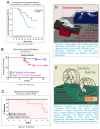Arrhythmogenic Cardiomyopathy: Exercise Pitfalls, Role of Connexin-43, and Moving beyond Antiarrhythmics
- PMID: 35955883
- PMCID: PMC9369094
- DOI: 10.3390/ijms23158753
Arrhythmogenic Cardiomyopathy: Exercise Pitfalls, Role of Connexin-43, and Moving beyond Antiarrhythmics
Abstract
Arrhythmogenic Cardiomyopathy (ACM), a Mendelian disorder that can affect both left and right ventricles, is most often associated with pathogenic desmosomal variants that can lead to fibrofatty replacement of the myocardium, a pathological hallmark of this disease. Current therapies are aimed to prevent the worsening of disease phenotypes and sudden cardiac death (SCD). Despite the use of implantable cardioverter defibrillators (ICDs) there is no present therapy that would mitigate the loss in electrical signal and propagation by these fibrofatty barriers. Recent studies have shown the influence of forced vs. voluntary exercise in a variety of healthy and diseased mice; more specifically, that exercised mice show increased Connexin-43 (Cx43) expression levels. Fascinatingly, increased Cx43 expression ameliorated the abnormal electrical signal conduction in the myocardium of diseased mice. These findings point to a major translational pitfall in current therapeutics for ACM patients, who are advised to completely cease exercising and already demonstrate reduced Cx43 levels at the myocyte intercalated disc. Considering cardiac dysfunction in ACM arises from the loss of cardiomyocytes and electrical signal conduction abnormalities, an increase in Cx43 expression-promoted by low to moderate intensity exercise and/or gene therapy-could very well improve cardiac function in ACM patients.
Keywords: arrhythmogenic cardiomyopathy; connexin-43; exercise; fibrofatty infiltration.
Conflict of interest statement
Salary support to S.P.C. from Pfizer, Inc.; J.R.P., M.L.-V. and I.L.C. declare no conflict of interest.
Figures

Similar articles
-
Remodelling of myocardial intercalated disc protein connexin 43 causes increased susceptibility to malignant arrhythmias in ARVC/D patients.Forensic Sci Int. 2017 Jun;275:14-22. doi: 10.1016/j.forsciint.2017.02.020. Epub 2017 Feb 27. Forensic Sci Int. 2017. PMID: 28288337
-
Sudden Death and Left Ventricular Involvement in Arrhythmogenic Cardiomyopathy.Circulation. 2019 Apr 9;139(15):1786-1797. doi: 10.1161/CIRCULATIONAHA.118.037230. Circulation. 2019. PMID: 30700137 Free PMC article.
-
Connexin defects underlie arrhythmogenic right ventricular cardiomyopathy in a novel mouse model.Hum Mol Genet. 2014 Mar 1;23(5):1134-50. doi: 10.1093/hmg/ddt508. Epub 2013 Oct 9. Hum Mol Genet. 2014. PMID: 24108106 Free PMC article.
-
Arrhythmogenic Cardiomyopathy in 2018-2019: ARVC/ALVC or Both?Heart Lung Circ. 2019 Jan;28(1):164-177. doi: 10.1016/j.hlc.2018.10.013. Epub 2018 Oct 24. Heart Lung Circ. 2019. PMID: 30446243 Review.
-
Sudden death related cardiomyopathies - Arrhythmogenic right ventricular cardiomyopathy, arrhythmogenic cardiomyopathy, and exercise-induced cardiomyopathy.Prog Cardiovasc Dis. 2019 May-Jun;62(3):217-226. doi: 10.1016/j.pcad.2019.04.002. Epub 2019 Apr 17. Prog Cardiovasc Dis. 2019. PMID: 31004608 Review.
Cited by
-
A perspective on Notch signalling in progression and arrhythmogenesis in familial hypertrophic and dilated cardiomyopathies.Philos Trans R Soc Lond B Biol Sci. 2023 Jun 19;378(1879):20220176. doi: 10.1098/rstb.2022.0176. Epub 2023 May 1. Philos Trans R Soc Lond B Biol Sci. 2023. PMID: 37122209 Free PMC article. Review.
-
Desmosomes in Cell Fate Determination: From Cardiogenesis to Cardiomyopathy.Cells. 2023 Aug 22;12(17):2122. doi: 10.3390/cells12172122. Cells. 2023. PMID: 37681854 Free PMC article. Review.
-
Advances in Ion Channel, Non-Desmosomal Variants and Autophagic Mechanisms Implicated in Arrhythmogenic Cardiomyopathy.Curr Issues Mol Biol. 2023 Mar 7;45(3):2186-2200. doi: 10.3390/cimb45030141. Curr Issues Mol Biol. 2023. PMID: 36975511 Free PMC article. Review.
-
Efficacy and Safety of Angiotensin Receptor Blockers in a Pre-Clinical Model of Arrhythmogenic Cardiomyopathy.Int J Mol Sci. 2022 Nov 11;23(22):13909. doi: 10.3390/ijms232213909. Int J Mol Sci. 2022. PMID: 36430389 Free PMC article.
-
Endurance Training Provokes Arrhythmogenic Right Ventricular Cardiomyopathy Phenotype in Heterozygous Desmoglein-2 Mutants: Alleviation by Preload Reduction.Biomedicines. 2024 Apr 30;12(5):985. doi: 10.3390/biomedicines12050985. Biomedicines. 2024. PMID: 38790949 Free PMC article.
References
-
- Chelko S.P., Asimaki A., Lowenthal J., Bueno-Beti C., Bedja D., Scalco A., Amat-Alarcon N., Andersen P., Judge D.P., Tung L., et al. Therapeutic Modulation of the Immune Response in Arrhythmogenic Cardiomyopathy. Circulation. 2019;140:1491–1505. doi: 10.1161/CIRCULATIONAHA.119.040676. - DOI - PMC - PubMed
-
- Asimaki A., Tandri H., Duffy E.R., Winterfield J.R., Mackey-Bojack S., Picken M.M., Cooper L.T., Wilber D.J., Marcus F.I., Basso C., et al. Altered desmosomal proteins in granulomatous myocarditis and potential pathogenic links to arrhythmogenic right ventricular cardiomyopathy. Circ. Arrhythmia Electrophysiol. 2011;4:743–752. doi: 10.1161/CIRCEP.111.964890. - DOI - PMC - PubMed
Publication types
MeSH terms
Substances
Grants and funding
LinkOut - more resources
Full Text Sources

